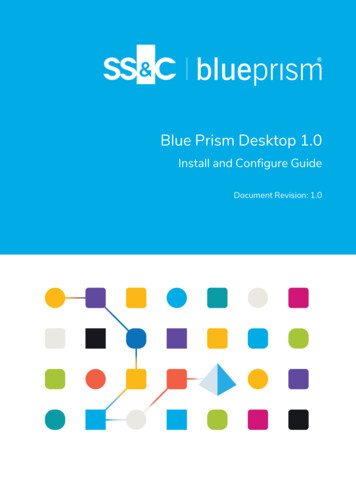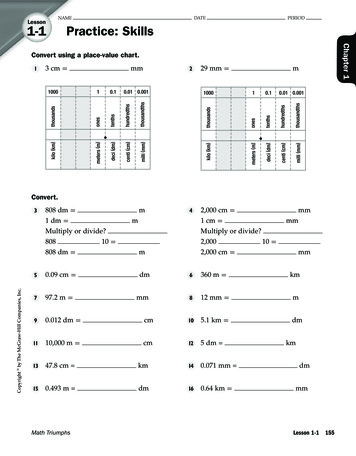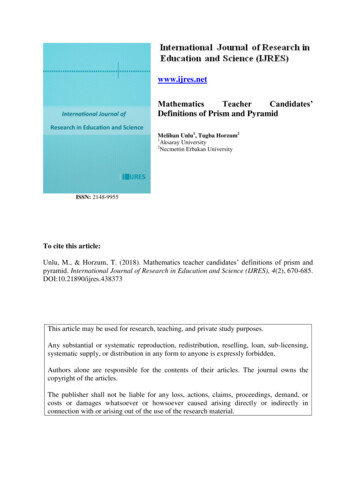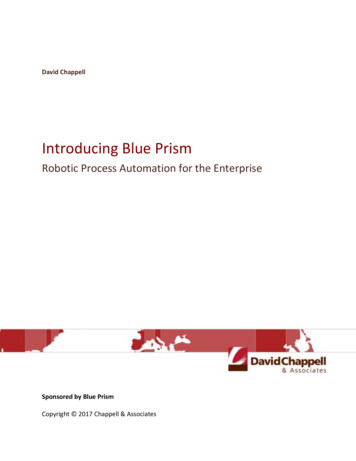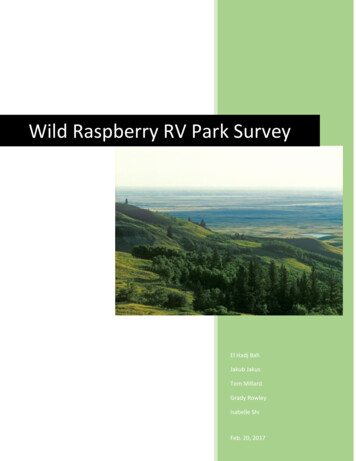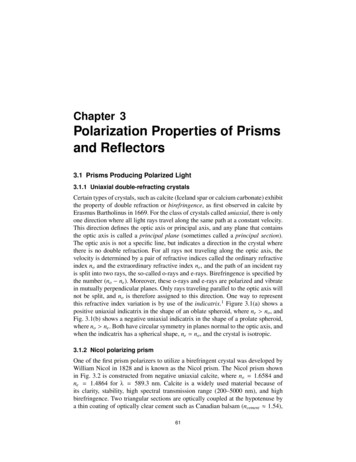
Transcription
Blue Prism 7.0Cloud DeploymentsDocument Revision: 1.0
Blue Prism 7.0 Cloud DeploymentsTrademarks and CopyrightTrademarks and CopyrightThe information contained in this document is the proprietary and confidential information of Blue PrismLimited and should not be disclosed to a third-party without the written consent of an authorized BluePrism representative. No part of this document may be reproduced or transmitted in any form or by anymeans, electronic or mechanical, including photocopying without the written permission of Blue PrismLimited. Blue Prism Limited, 2001 – 2021 “Blue Prism”, the “Blue Prism” logo and Prism device are either trademarks or registered trademarks ofBlue Prism Limited and its affiliates. All Rights Reserved.All trademarks are hereby acknowledged and are used to the benefit of their respective owners.Blue Prism is not responsible for the content of external websites referenced by this document.Blue Prism Limited, 2 Cinnamon Park, Crab Lane, Warrington, WA2 0XP, United Kingdom.Registered in England: Reg. No. 4260035. Tel: 44 870 879 3000. Web: www.blueprism.comCommercial in ConfidencePage ii
Blue Prism 7.0 Cloud DeploymentsContentsContentsTrademarks and CopyrightContentsiiiiiIntroductionCloud deploymentsIntended audienceAbout this documentivivivAbout Blue Prism cloud deploymentsCloud deployment modelsvvCommon design considerationsNetwork connectivityHybrid deploymentsLoad balancingviiviiviiiviiiApplication managementOrchestrationand scalingviiiviiCommercial in ConfidencePage iii
Blue Prism 7.0 Cloud DeploymentsIntroductionCloud deploymentsIntroductionCloud deploymentsIntended audienceThis reference guide is intended for use by system architects and designers who are seeking to gain anunderstanding of the options and considerations for deploying a Blue Prism environment in the cloud.About this documentThe document provides an overview of the key considerations for a cloud based deployment of BluePrism. It is intended as a high level overview of the common concepts and considerations and how theyrelate to the Blue Prism design. An understanding of the Blue Prism application architecture (asdocumented in the Infrastructure Reference guide and other documents) is expected. Further platformspecific Reference Architecture is available separately.Commercial in ConfidencePage iv
Blue Prism 7.0 Cloud DeploymentsAbout Blue Prism cloud deploymentsAbout Blue Prism cloud deploymentsThe concepts and subject matter for Cloud are very broad and may cover many different patterns ofdeployment. This section outlines some of the common concepts involved in assessing a Cloud baseddeployment of Blue Prism and the pre-requisite considerations for determining the appropriate modeland platform. Further specific documentation is available, where reference architecture is documented fora specific platform.Cloud deployment modelsThere are several common cloud deployment models that are referred to. These are briefly explained inthe following table, along with some key points that would need to be considered for a Blue Prismdesign.Cloud ModelExamplesHigh Level ConsiderationsPublic Cloud – Refers to theprovision of applications,platforms or storage over theinternet.AWS, Microsoft Azure, GoogleCloud, SoftlayerConsider the overall Cloudstrategy. Selection of a clouddeployment pattern for BluePrism is likely to need to alignclosely to this.The limitations of sharedhardware resources andfacilities of the cloud platformshould be taken into account.Private Cloud – Refers to thedeployment of an environmentthat has similar advantages topublic cloud – e.g. elasticity,platform services) – but througha proprietary architecture that isdedicated to an organisation.Either within the organisationsdata center or increasingly,referring to the provision ofdedicated components within acloud provider’s datacenter.Mware, Rackspace, Softlayer,OVHThe underlying virtualizationand orchestration technology islikely to be the primary factor indetermining suitability for aBlue Prism deploymentInfrastructure as a Service(IAAS) – Refers to the provisionof infrastructure (compute /VMs) within a cloudenvironment, where theunderlying hardware platform issupported by the vendor.WS, Microsoft Azure, GoogleCloud, SoftlayerThe platform specific limitationsaround High Availability andDisaster Recovery should becarefully considered against thenon-functional requirements.Offerings in this space varybetween platforms and need tobe compared against thegeneric requirements for theBlue Prism platform (asdocumented within theInfrastructure Reference Guide)Commercial in ConfidencePage v
Blue Prism 7.0 Cloud DeploymentsCloud deployment modelsCloud ModelExamplesHigh Level ConsiderationsPlatform as a Service (PAAS) –Refers to cloud deploymentpatterns where the underlyingplatform (e.g. Microsoft SQL) issupported by the cloudprovider. Some limitations willexist around the flexibility of theservice as a result.AWS, Microsoft Azure, GoogleCloud, SoftlayerSuitability of Platform as aService database patterns maybe restricted by non- functionalrequirements, such asscalability, security andavailability.Software as a Services (SAAS)– Refers to a delivery modelwhere software is licensed andhosted on a subscription model(generally public cloud hosted).Vendor dependant.Hybrid – Generally refers to ascenario where a public cloudand on premise solution arecombined to provide an overallarchitecture.VariousSupport for a hybriddeployment of Blue Prism (e.g.Database and App server in thecloud, runtimes on premise) isnot currently formallysupported. Some workaroundsmay be discussed on anindividual basis and formalsupport will be added soon.Hosted Bare Metal – Somecloud providers offer the abilityto provision and self manage anenvironment from OS andabove. For example, anorchestrated build of aHypervisor, such as VMwarevSphere.Softlayer, Rackspace, OVHSome advantages may begained in highly securityconscious clients, where themanagement and security ofthe operating system andhypervisor layer must becontained.Blue Prism as an application init’s own right is not currentlyoffered directly via PAASplatforms such as Azure andAWS marketplace.Blue Prism does not directlyprovide a SAAS offering.Partners may choose to deliverthis type of model.Designing a SAAS deploymentmodel is complex and will needto consider many aspects.These include – physicalsegregation, logical segregation(within the platform andsoftware), security, cost vssimplicity, external networkconnectivity.Commercial in ConfidencePage vi
Blue Prism 7.0 Cloud DeploymentsCommon design considerationsCommon design considerationsThe deployment of Blue Prism on a Cloud environment does not change the core requirements of theBlue Prism application. The Infrastructure Reference Guide has full details on the sizing andcommunication requirements of the application, however some commonly applicable points to considerwhen deploying in a cloud hosting environment will be:Network connectivityThe primary consideration for assessing the suitability of deploying Blue Prism on cloud is the proximityand connectivity to the managed applications and between Blue Prism components. Consider that theRuntimes and Development Interactive Clients will need to have connectivity and sufficient bandwidth toautomate target applications in external networks. The following should be assessed: The communication that takes place between Blue Prism components requires the ability toresolve the IP address of the target machine by name. The DNS and DHCP configuration within thecloud hosting environment should be understood before deployment. Location of the applications - are the applications in scope primarily cloud hosted, internet, or onpremise hosted? Type of applications – are the applications to be automated web based or thick client? This willhave an impact on bandwidth and performance requirements. Are the applications routable from the cloud network – this may well require some routing changesor Network Address Translation for the target applications What is the available connectivity - what connectivity is in place / will be in place between thecloud hosting network and the target network(s)? What is the available bandwidth – what is the total bandwidth required by the applications to beautomated and is this within the parameters of available bandwidth?Application managementThe runtimes and development interactive clients will require the full stack of applications locally installedto automate their target processes (unless an additional application virtualization technology will be usedto layer this on top). The mechanism for installing, licensing and maintaining these applications must beconsidered in determining whether a cloud hosting pattern is feasible. Some implications of considering acloud deployment pattern are: How will applications be deployed, patched and scanned? Licensing of the applications – terms may change if moved to the cloudCommercial in ConfidencePage vii
Blue Prism 7.0 Cloud DeploymentsOrchestration and scalingOrchestration and scalingThe orchestration and auto-scaling of Blue Prism components must consider the following: Blue Prism licensing – Any scaling out of Runtimes must be within the licensed capacity of the BluePrism environment Application stack – The scaling out of Runtimes or Interactive Clients for development will need toalso consider the deployment of any managed application stacks Blue Prism configuration – The configuration of the Runtimes or Interactive Clients andconnectivity to the appropriate application server will need to be considered in any orchestrationscripts Database objects – A Blue Prism runtime or Interactive Client will create objects within the BluePrism database on first connection. If scaling down or redeploying dynamically, these objects willneed to be cleaned up.Hybrid deploymentsThe deployment of a hybrid pattern (where the Blue Prism environment is deployed in the Cloud andRuntimes are deployed remotely) is not formally supported in versions that rely on .NET remoting, as itdoes not support Network Address Translation (NAT). Blue Prism will add support for this type of patternin the future release that moves to using WCF. At this time, the reference architectures will be updated toreflect these supported patterns and any recommendations.Load balancingThe use of load balancers within IAAS providers (such as Azure or AWS) is not supported in versionsthat rely on .NET remoting, for the same reasons as above (limitations of .NET remoting). The support forload balancing will be added alongside the support of WCF in version 6.0.Commercial in ConfidencePage viii
Load balancing The use of load balancers within IAAS providers (such as Azure or AWS) is not supported in versions that rely on .NET remoting, for the same reasons as above (limitations of .NET remoting). The support for load balancing will be added alongside the support of WCF in version 6.0. BluePrism7.0 CloudDeployments Orchestrationandscaling
